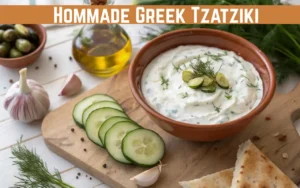While Greek desserts are often rich and indulgent, many are rooted in whole ingredients like nuts, olive oil, honey, and semolina. That said, understanding their nutritional content can help you enjoy them mindfully—especially if you’re watching your sugar intake, counting calories, or following a Mediterranean-style diet
This article breaks down the calorie counts, sugar levels, and potential health swaps for some of the most popular Greek sweets.
Table of Contents
Calorie Counts per Serving
Baklava
- 1 piece (approx. 2×2 inch square): 290–330 calories
- Source of: healthy fats from walnuts, simple carbs, high sugar content from syrup
Galaktoboureko
- 1 slice: 250–300 calories
- Made with semolina custard and filo, then soaked in lemon syrup
Melomakarona
- 1 cookie: 160–200 calories
- Olive oil-based, eggless, sweetened with honey or syrup
Kourabiedes
- 1 cookie: 200–240 calories
- Rich in butter and almonds, heavily dusted with powdered sugar
Loukoumades
- 4–5 puffs: 250–300 calories
- Deep-fried dough balls soaked in honey or sugar syrup
Halva (Semolina)
- 1 slice: 180–220 calories
- Made with olive oil or seed oil, semolina, and sugar syrup
Explore healthy alternatives in Top 5 Greek Vegan Desserts
Sugar and Carb Content
Most traditional Greek desserts rely on syrup or powdered sugar for sweetness.
- Baklava: High sugar (~20–25g per serving)
- Galaktoboureko: Medium (~15–18g)
- Loukoumades: High due to honey soak (~20g)
- Melomakarona: Medium (~12–16g), lower glycemic impact with olive oil
- Halva: Medium, depends on syrup concentration
Healthier Swaps and Versions
- Use agave or maple syrup instead of honey for lower glycemic impact
- Replace white sugar with coconut sugar or date syrup
- Bake instead of fry where possible (e.g., for loukoumades alternatives)
- Use whole wheat or almond flour in cookies like melomakarona
Mediterranean Diet Compatibility
While many Greek desserts are high in calories, they align with the Mediterranean diet philosophy when:
- Made with olive oil instead of butter
- Sweetened with natural syrups
- Eaten in moderation, ideally paired with fruit or tea
Dessert Choices for Diabetics or Low-Sugar Diets
- Pasteli: Honey and sesame bar, high in fat but less added sugar
- Fruit preserves (glyka tou koutaliou): Can be portioned precisely
- Raw nut and date energy bites: Modern Greek-style, inspired by halva
Frequently Asked Questions
Is baklava healthy?
It’s calorie-dense and sugary, but contains healthy fats from nuts. Enjoy in small portions.
Are any Greek desserts good for low-sugar diets?
Melomakarona with reduced syrup, or pasteli made without added sugar, are better options.
Can I make lighter versions at home?
Yes—use less syrup, opt for whole grain flours, and bake instead of fry where possible.
Return to the Ultimate Guide to Greek Desserts for more insights





2 thoughts on “Nutritional Breakdown of Popular Greek Desserts”
Comments are closed.